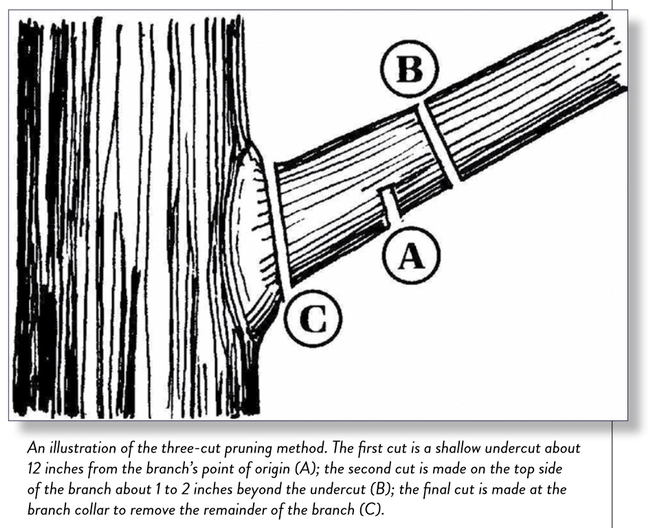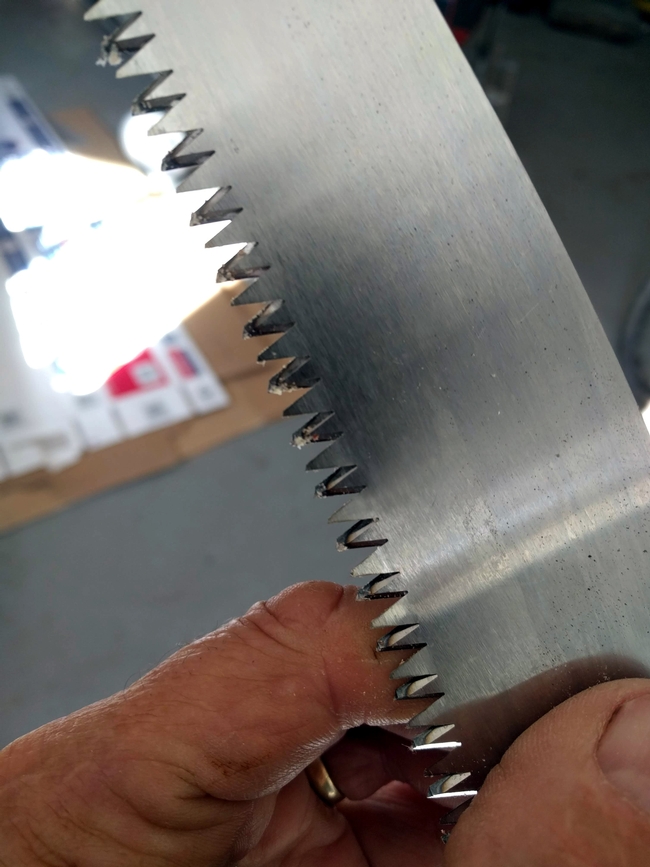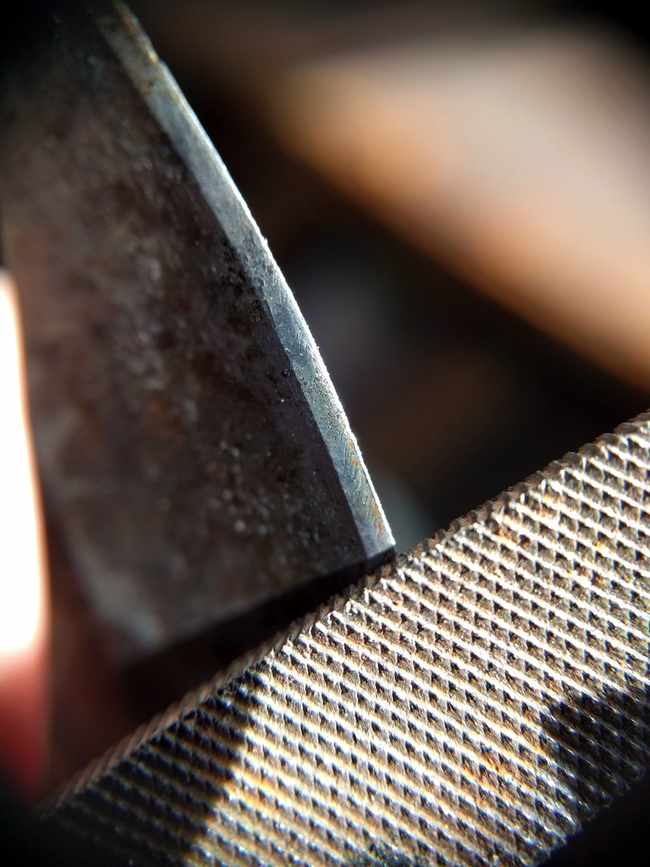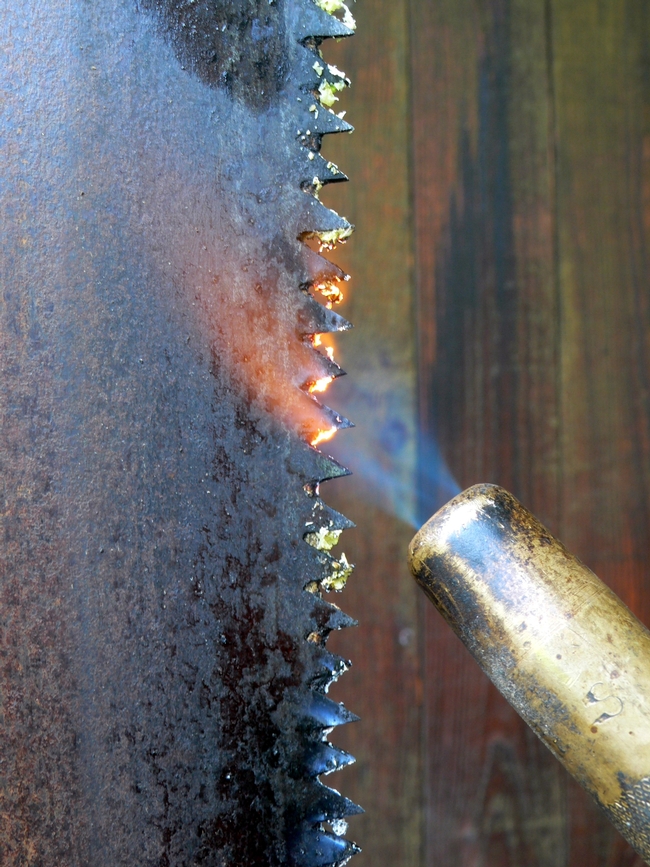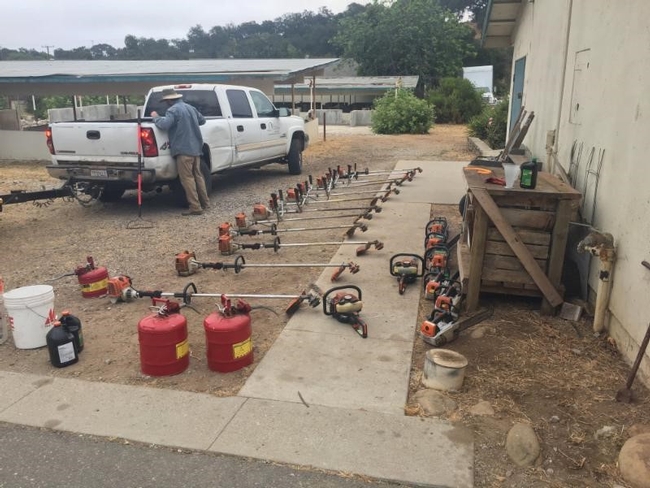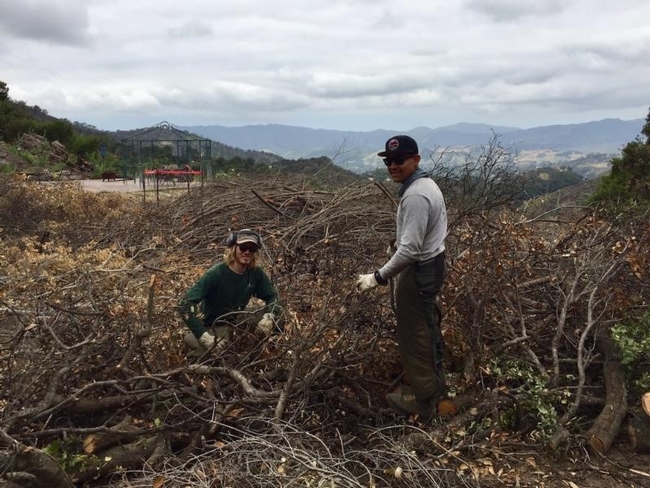
Posts Tagged: pruning
Wise Words on Pruning
From Tim Spann, Spann Ag Research & Consulting
Use Sharp Tools in order to make Clean Cuts
Follow 3-Cut Method for larger branches
Whitewash with more extensive pruning
Watch the Weather
And Don't Apply Pruning Paint
Pictured: 3-Cut Method

pruning
Avocado Tree Pruning Worldwide
Pruning is a difficult topic to discuss and describe and to arrive at a consistent approach from year to year.
And now Simon Newett, Bridie Carr and Renata Grunennvaldt have put together a survey of what avocado growers worldwide are doing to control vegetative growth. The survey was conducted through an avocado industry extension project funded by Australian grower levies, Hort Innovation Ltd (Australia) and the Queensland governments (Hort Innovation Limited & DAF). Thank them for their efforts.
Obviously the methods and results reported in the survey will vary according to the characteristics of the orchard and the environment in which the trees are grown. And whether a plant growth regulator is used, such as uniconazole or propiconazole, to retard growth.
The most interesting findings were the popularity of selective limb removal, the younger tree age in which pruning is now commenced, the smaller tree size being aimed for and the fact that most people try to remove about 20% of the canopy each year.
Check out what other growers are doing in their orchards by clicking on the link at the bottom of the page.

pruning avocado
Tree Decay
Proper pruning and tree care are important in most trees, including citrus and avocado. The question of what decay fungus is happening to a tree often comes up and a recent UC publication can help answer that question
Wood Decay and Fungi in Landscape Trees by Downer and Perry
The other question of what to do about the fungus is answered, as well. Check it out.
IDENTIFICATION AND BIOLOGY OF DECAY FUNGI
Many wood decay fungi can be identified by the distinctive shape, color, and texture of the fruiting bodies they form on trees. These fruiting bodies take several forms, depending upon the fungus that produces them, but most of them fit into categories commonly referred to as mushrooms, brackets or conks. They often grow near wounds in bark, including old pruning wounds, at branch scars, in proximity to the root crown, or near surface anchor roots. Some decay fungi, such as Armillaria mellea, produce fleshy mushrooms at the base of infected trees or along their roots, often after rain in fall or winter. All mushrooms and some bracket fungi are annual (i.e., appearing and disappearing seasonally), but many conks are perennial and grow by adding a new spore-bearing layer (hymenium) each year.
Decay fungi are divided into those that attack heartwood (causing heart rots) and those that attack sapwood (causing sap rots and canker rots). Further subdivision is based on the appearance of the decayed wood (i.e., white rots, brown rots, and soft rots) or location in the tree (the decay is called a butt rot if it is at the base of the trunk). Canker rots usually appear on branches or the trunk. When a fruiting body is visible on a tree, it is usually associated with advanced decay; the extent of decay may be far above or below the location of the fruiting body. Trees with extensive sap rot may show symptoms of decline, including increased deadwood and a thinning canopy with reduced density of foliage.
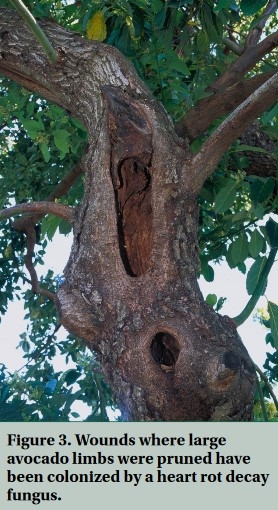
avocado tree decay
Pruning Tips from a Horticulturist
Tuning up for Pruning Up--Care, Maintenance and Utilization of Hand Pruning Tools
J. Downer
University of California
Fall is passing into winter and the bare sticks in my deciduous fruit orchard are calling me to my annual fruit tree pruning chores. I can prune my entire orchard with very few tools: a good pair of bypass clippers, a similar set of loppers (optional) and a high quality “razor” or “tri edge” saw. Most tools require some maintenance especially the clippers and loppers. Sharpening is the usual need. Clippers are easily sharpened but modern saw blades can not be sharpened by gardeners and should be replaced. Sometimes it is just as easy to buy a new saw, replacing the old one when blade eventually dulls or is bent from over zealous use (illustration 1)
Illustration 1: Tri-edge saw blades are made from stainless steel and are not easily sharpened. When dull or bent they should be replaced
Before using your pruning tools inspect them for signs of damage. Blades should be sharp and unbent. Loppers should have their rubber “bumpers” intact otherwise your knuckles will be smashed after exerting force on a difficult branch. Sharp tools offer less resistance and actually decrease injury to users. One exception here is with the modern “tri-edge” or “razor” saws. These saws can cut so quickly that you may pass through the branch you are cutting and continue on to some part of your anatomy quickly ripping your flesh. I have suffered more cuts (some serious) from these saws than from any other gardening activity. They should be used with careful precision, not with the wild abandon and pruning fervor of the craven academic desperate for real world gardening experience. A thick long sleeved shirt and gloves will also help prevent cuts from hand pruning equipment.
Bypass clippers are so termed because the blade passes by the hook. To sharpen these, find the bevel on the edge of the clippers and align a small file to the same angle of this bevel, and file the bevel until you can feel the sharpness with your finger (Illustration 2). Never sharpen the back side of the bevel—this will create a gap, and every time you cut, a flap of tissue will remain. Back bevel sharpened clippers will require blade replacement or grinding until the back bevel is gone. The hook does not require sharpening, do not attempt to file it. Repeat this process with lopper blades.
Illustration 2: To sharpen bypass clipper blades follow the angle of the bevel. Do not sharpen the flat side of the blade
When you are done pruning for the day, wipe the blades of your clippers and loppers with an oil soaked rag or apply a few drops of oil and rub it into the blade. Most modern saws blades are made from stainless steel and require no oil protection.
As a Cooperative Extension Advisor, one of the most common questions I receive is: “Should I sanitize my clippers between cuts or between uses on various plants?”. Indeed, many publications, extension leaflets, gardening columns, and other sources make broad recommendations to sanitize clippers after every cut. Some articles even compare various products for their killing efficacy. Often blind recommendations are made to sanitize clippers when the pathogen is not even known or specified. It is not necessary to sanitize your clippers when pruning most garden plants and fruit trees. There are a few pathogens that are spread by dirty pruning equipment but published evidence that they are spread by hand pruning equipment (especially clippers) is nil. One exception is palm wilt caused by Fusarium oxysporum f.sp. canariensis which is easily spread by saws. Some of the canker fungi caused by Botryosphaeria can also be spread by pruning equipment. With many of these pathogens, a wound is required for infection so it may not be that the clippers are spreading disease so much as providing an entry point (infection court) so that pathogens have a way to enter.
In my garden, I have never, and will never need to sanitize clippers between cuts. However, conditions vary across the US, and in some places rain, humidity, and temperature are more favorable for disease development. To avoid spreading pathogens, prune during the dormant season, when the likelihood of pathogen activity is lowest. Apply dormant sprays containing copper to limit the onset of new fungal diseases that may enter pruning wounds. If you still feel you need to protect wounds from dirty clippers I like to use the flame from a plumber's torch to sanitize. A few seconds along the cutting edge front and back kills all pathogens (Illustration 3). Similar for a saw but efficacy is increased if the saw gullets are wiped clean with a cloth and then the flame applied. The only time I take these measures is when I know I am working with plants that can be inoculated with pathogens by pruning (which is rare).
Illustration 3: A plumber's torch will rapidly sanitize saws and blades when pathogens are present in plant tissues.
When pruning garden plants, there are a plethora of recommendations on how to make cuts. Rose experts have extolled the virtues of an angled cut so water runs away quickly, flush cuts used to be recommended by arborists as the highest quality cut. These examples are without research foundation. Cuts on woody plants should be angled to produce a circular exposure that is the smallest surface area possible. We abandoned flush cuts many years back because they cut into protective zones that limit decay in trees. Some gardeners feel compelled to cover their cuts with a pruning paint and there is a similar paucity of research to support this practice. Leave pruning wounds unpainted.
Got Brush? Fire Clearance and Tree Pruning CREW
Got trees/brush to remove?
The CREW is ready to work:
With a decline in federal funding to work on Forest Service lands and elsewhere our local non-profit, The CREW is looking for work. They are great at getting all kinds of brush cleared, trees removed and as a non-profit their rates are reasonable. In hiring The CREW you are helping train a new generation of folks to use saws and work in the field.
If you have need for dead trees/limbs to be removed, one local resource is The C.R.E.W. - Concerned Resource & Environmental Workers. Since 1991 this Ojai-based nonprofit has provided paid employment to young people in conservation and forestry work. With a workforce trained in chainsaw use for fire abatement, The C.R.E.W. is available at a reasonable fee to take down trees and limbs in orchards. They also have a chipper.
The C.R.E.W. works throughout Ventura and Southern Santa Barbara counties. In fact, The C.R.E.W. was hired in 2016 by California Citrus Mutual to take out neglected orange trees on private property to limit growers' exposure to ACP/HLB.
If you're interested in learning more, contact Todd Homer at thomer@thecrew.org or call 805-649-8847.
CREW Equipment Ready
The CREW does great fire clearance.

